Chao Ga is a savoury, silky, thick, comforting, and filling Vietnamese chicken and rice soup or porridge that is as easy to make as it is budget friendly! Whether you serve this chicken congee for breakfast, lunch, or dinner, you’re going to love the fresh, vibrant Vietnamese flavours in this fast, fabulous, delicious dish.
For an aromatic dish that bursts with flavour, this recipe is shockingly easy to prepare. And while it will undoubtedly fill you up, it’ll do so for pennies and won’t leave you feeling weighed down.
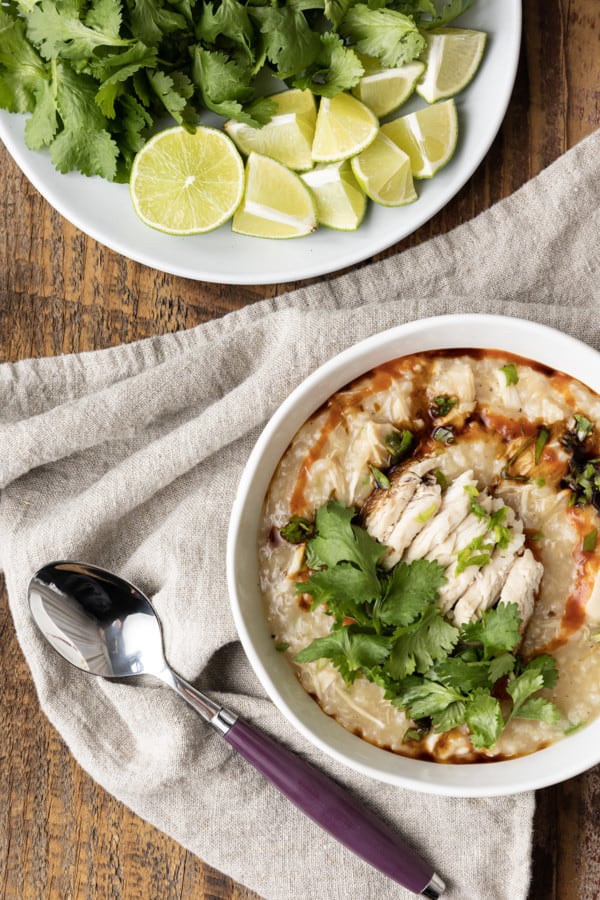
This is a first food for many children in Vietnam and ex-pat communities worldwide. It is also a food that is served to folks who are feeling under the weather.
You can serve it plain in its unadorned and understated glory, or you can go all in and wantonly strew your bowl like I do. All the garnish for this gal, please!
Fresh cilantro, bean sprouts, and green onions join with crispy fried shallots and garlic, soft-boiled eggs, hot sauce, and black garlic vinegar as my favourite toppers for this irresistible chicken congee. The contrast of hot, silky chicken and rice porridge with the cold herbs and crunchy fried shallots and garlic is swoon-worthy.
Chicken Congee
Chao Ga is the Vietnamese version of a rice dish served all over Asia and throughout the Asian diaspora. Known variously as congee, juk, jook, okayu, kanji, zosui, lugaw, and more, there are almost as many varieties of it as there are names.
As much as the name varies depending on geography, the thickness of chao ga varies from town to town and home to home. Our version of cháo gà is thick enough to stay on your spoon without running off, but still thin enough to slurp if the spirit moves you.
One thing that all of these variations on rice porridge have is that you’re cooking it long enough to basically dissolve the rice grains into the water or stock. It creates a super silky texture that is filling but light, and meltingly soft but still retains a little chew.
As if all of this isn’t enough to recommend it, let’s talk about the economics of the dish. Chao ga is one of the most frugal-yet-filling dishes you can imagine.
We’re talking about a recipe that uses 1 cup of rice to 10 cups of stock and yields enough to fill 5 adults to capacity. That is not a typo.
Chicken Porridge
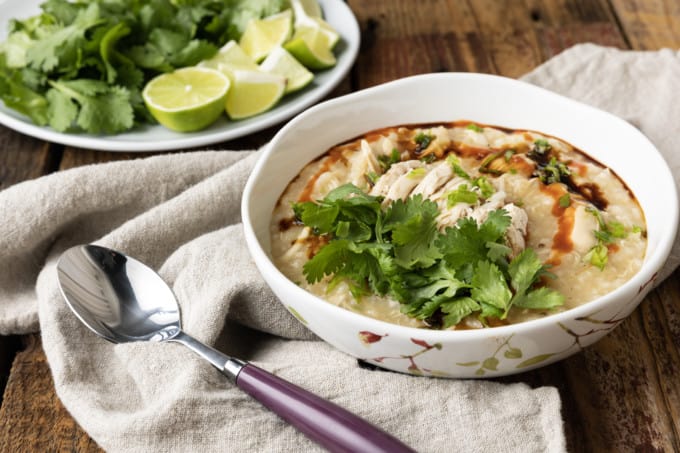
Before you hit it with garnish, this comforting porridge doesn’t look like much. It’s off white or beige and thick but translucent.
Your nose will be telling you this is something you want to eat, though. Chao Ga’s aroma is just so enticing you can’t help but dig in.
…a word of warning though. No matter how good that chao ga smells, you may want to let it cool longer than you might otherwise think necessary.
It holds onto heat like a lava flow! Believe me when I tell you that I’ve regretted a hasty spoonful more times than I can count.
Once you squeeze a lime wedge or two over it and garnish it abundantly with all sorts of goodies it’ll transform into a feast for the eyes, too.
How to Make Rice Porridge
Let’s give you the quick list of ingredients and equipment needed to make your chicken rice porridge.
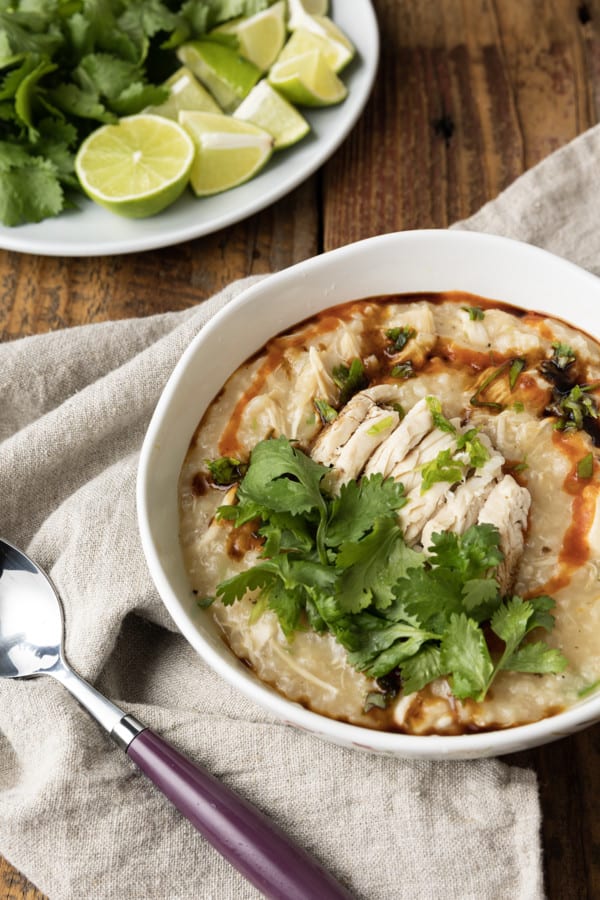
Ingredients
- Chicken broth, chicken stock, or mushroom stock
- Short or medium grain rice, preferably glutinous rice
- Green onions a.k.a. spring onions
- Fresh ginger, frozen first
- Garlic cloves
- Salt
- Black pepper or white pepper
- Boneless chicken breast or thighs
- Fish sauce (or soy sauce or liquid aminos)
- Lime wedges
- Cilantro or fresh herbs
- Optional but tasty: Soft or medium boiled chicken or duck eggs, tofu, chili crisp, garlic chili sauce, thinly sliced red onion, sesame oil, soy sauce, more fish sauce, black garlic sauce, hot sauce, fried garlic and shallots, pork floss, bean sprouts, or whatever makes you happy.
I like to use low sodium chicken broth or homemade chicken stock for my Vietnamese chao ga. I’ve also used and loved mushroom stock; use whatever dings your chimes.
The type of rice used in chao ga can vary from household to household. I’ve used almost every type of rice available to make it, depending on what I had on hand.
My all time favourite results come from making my Vietnamese chicken porridge with glutinous (a.k.a sweet) short-grain rice. Contrary to the sound of the name, though, there’s no gluten whatsoever in glutinous rice.
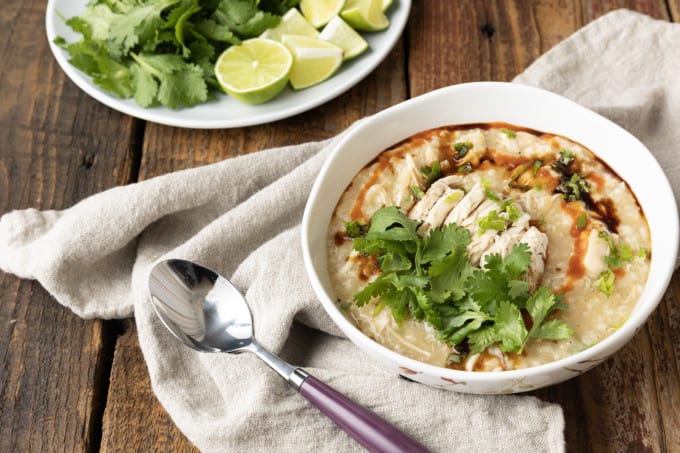
It came by the name because it becomes glue-like and sticky when cooked. But, like all varieties of rice, it is naturally gluten free.
If you can’t find sweet/glutinous rice, you can definitely use short grain sushi rice, medium grain rice, or even jasmine rice. I’ve made it with basmati, too, in a pinch.
I like the super silky texture the porridge takes on when made with shorter grain rices, though, so basmati only gets the nod when I’m low on other rice. You can use brown rice, but you’ll need to count on it taking longer for the rice to explode into silkiness in the broth.
If you’re an immovable fish sauce hater, you can certainly sub in soy sauce or liquid aminos in an equal quantity. It will lack some of the classic Vietnamese flavour in the final dish a bit, but will still be delicious.
I love to use boneless chicken breasts and boneless skinless chicken thighs in this for economical reasons. But you could alternately add shredded leftover rotisserie chicken as a garnish at the end, if preferred. This version of a chao ga recipe is not designed to be made with a whole chicken, although you’re welcome to simmer a chicken in three quarts of water with aromatics to make the chicken broth for this recipe.
If you do that, be sure to add the shredded chicken from the bones to your rice and chicken soup. We’ve also been known to make this with shredded or chopped leftover turkey on the day after Thanksgiving or leftover chicken from the grill!
HOT TIP ON HOW TO GRATE GINGER EASILY
And you may wonder why I suggest freezing the ginger in the recipe. I’m about to make your kitchen life so much easier!
When you freeze fresh ginger, you can grate it directly into a recipe without peeling it. Any tough peel will, well, peel away as you sweep it over a microplane. And the resulting grated ginger will be fluffy and fine; no stringy bits attached!
What to serve with chicken rice porridge
The garnish game can be strong with your chao ga! From soft-boiled egg or medium boiled chicken or duck eggs, to tofu, chili crisp, fried garlic and shallots, pork floss, bean sprouts, and more, chao ga is ripe for the topping.
The aim here is to complement the silky texture and hot temperature of the porridge with a little crunch and coolness. Because the porridge itself is so mild, you can really add some spice with your condiments, too.
Equipment
While classic congee can take hours on the stove top, this version is done much more quickly; about 45 minutes.
Our version doesn’t require more than occasional stirring as a time commitment. It also can be whipped up with equipment you probably already have in your kitchen!
- Cutting board
- Chef’s knife
- Measuring cup
- Measuring spoons
- Microplane or other fine grater
- Long handled spoon
- 4 quart capacity stock pot or soup pot
That list is pretty self explanatory and basic, but it’s all you need! Would you like to hear some other good news?
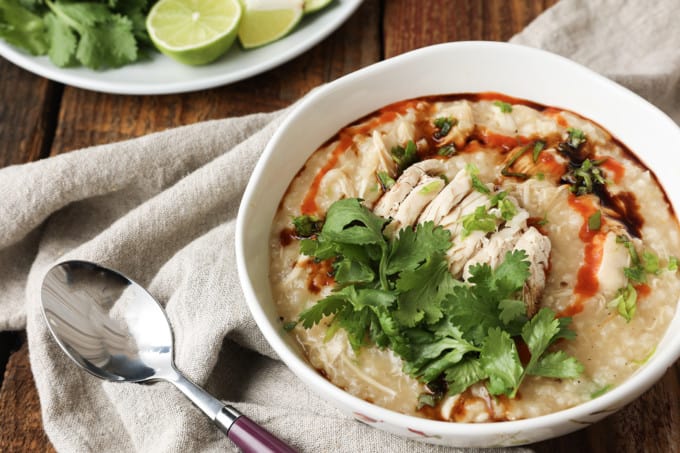
You can pop everything but the garnish into a slow cooker and cook it on low overnight with great results, too! Just imagine the wonder of waking up to a bubbling slow cooker of delightfully savoury Vietnamese rice porridge to start your day!
Chao ga (or other versions of congee) is one of the most requested breakfasts of all time in our household. It’s not just for when you’re feeling punky Chez Lindamood!
Chao Ga
Add broth, rice, the whites of the green onions, ginger, garlic, salt, and pepper to a large pot and bring to a rolling boil over medium heat. Stir frequently to prevent the rice from sticking.
Add the chicken pieces to the rice and stir well. Cover the pot, drop the heat to low, and simmer for 20-25 minutes. Add the fish sauce and simmer uncovered for 10 more minutes, or until the rice is basically exploded and no longer sinking and the chicken shreds easily with a fork or tongs.
Use the aforementioned tongs or spoon to break the chicken up into smaller pieces. It doesn’t have to be even or perfect, just mostly bite sized.
Scoop into bowls and serve with lime wedges and cilantro and whatever other garnish you love.
Leftover chao ga reheats beautifully in the microwave or in a small saucepan. If you reheat on the stovetop, just stir frequently to prevent scorching.
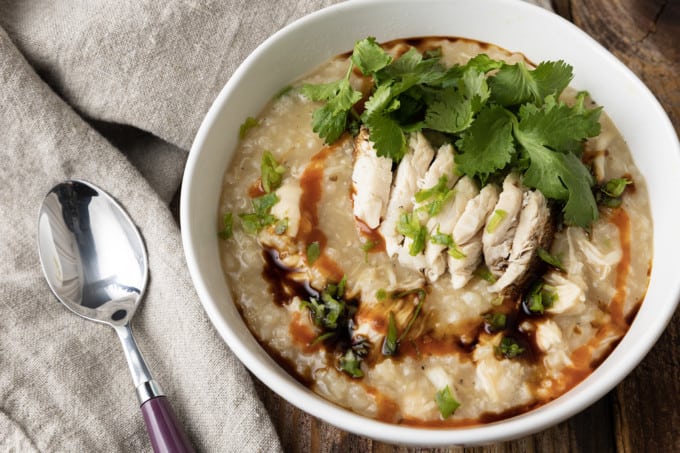
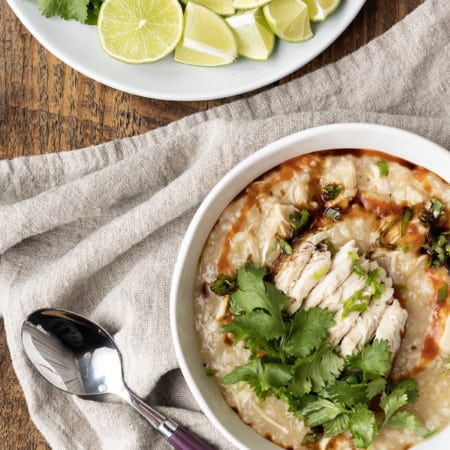
Chao Ga
Rate RecipeEquipment
- cutting board
- chef's knife
- Measuring cup
- measuring spoons
- Long Handled Spoon
- 4 quart capacity stock pot or soup pot
Ingredients
- 2 quarts chicken broth or stock
- 1 cup short or medium grain rice preferably glutinous rice, rinsed well under cold running water
- 1 bunch green onions whites thinly sliced, greens thinly sliced and reserved separately for garnish
- 2- inch piece of ginger frozen and grated
- 3 very large garlic cloves minced or grated
- 1 teaspoon kosher salt
- ½ teaspoon black pepper
- 4 boneless skinless chicken breasts or 5 boneless, skinless chicken thighs
- 3 tablespoons fish sauce see notes
For Serving
- Lime wedges cilantro
Optional but tasty:
- Soft or medium boiled chicken or duck eggs, tofu, chili crisp, sesame oil, soy sauce, more fish sauce, black garlic sauce, hot sauce, fried garlic and shallots, pork floss, bean sprouts, or whatever makes you happy.
Instructions
- Add broth, rice, the whites of the green onions, ginger, garlic, salt, and pepper to a large pot and bring to a rolling boil. Stir frequently to prevent the rice from sticking.
- Add the chicken pieces to the rice and stir well. Cover the pot, drop the heat to low, and simmer for 20-25 minutes. Add the fish sauce and simmer uncovered for 10 more minutes, or until the rice is basically exploded and no longer sinking and the chicken shreds easily with a fork or tongs.
- Use the aforementioned tongs or spoon to break the chicken up into smaller pieces. It doesn’t have to be even or perfect, just mostly bite sized.
- Scoop into bowls and serve with lime wedges and cilantro and whatever other garnish you love.
Notes
Nutrition
Nutritional information is an estimate and provided to you as a courtesy. You should calculate the nutritional information with the actual ingredients used in your recipe using your preferred nutrition calculator.
did you make this recipe?
Make sure to tag @foodiewithfam on Instagram and #hashtag it #foodiewithfamily so I can check it out!
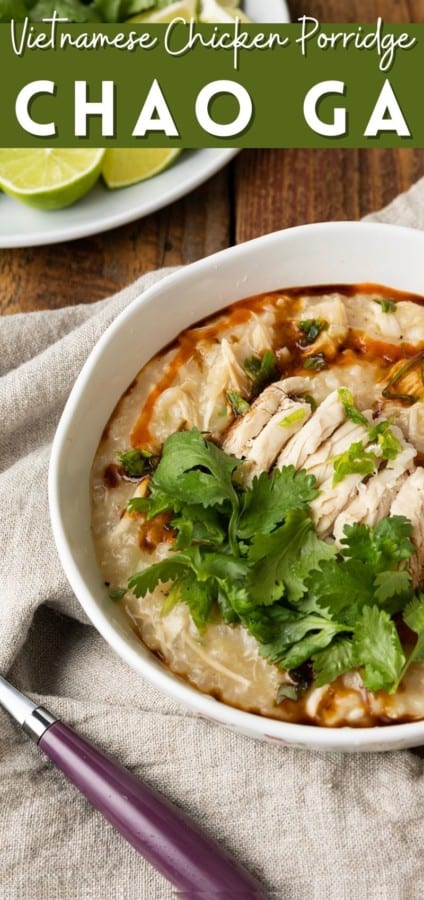
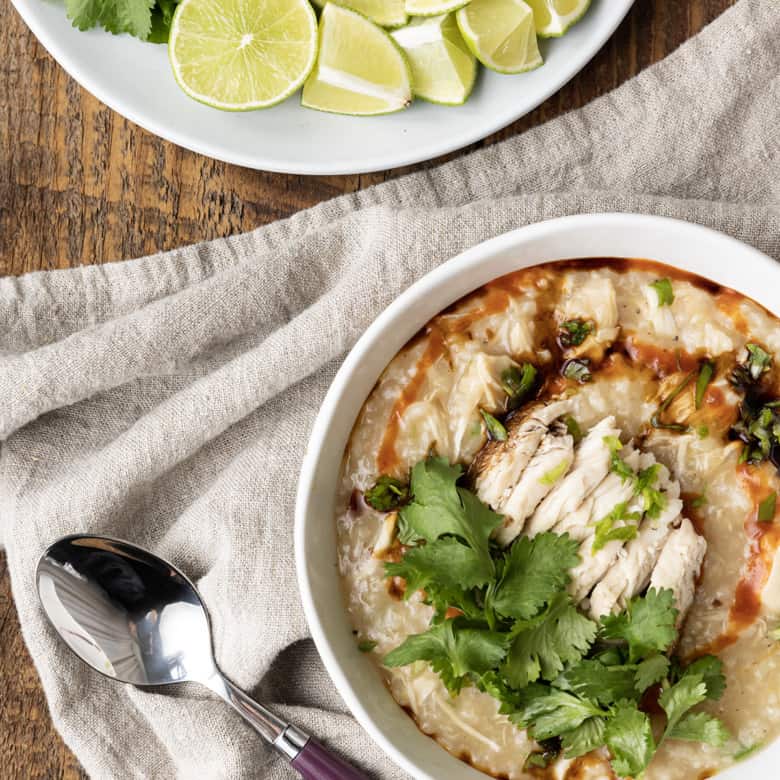



Comments + Reviews